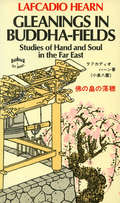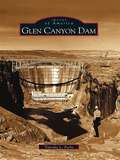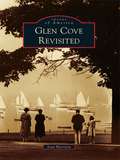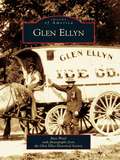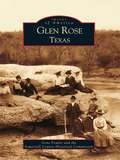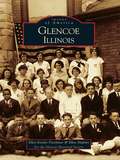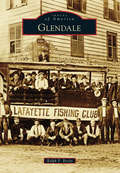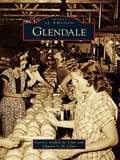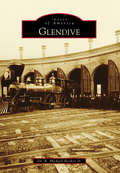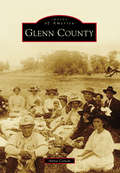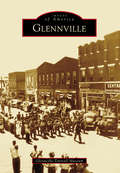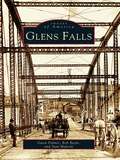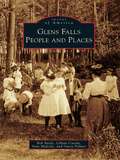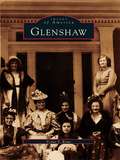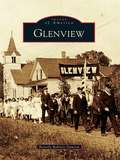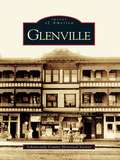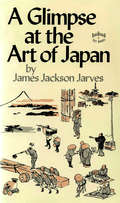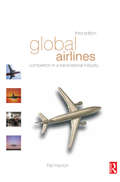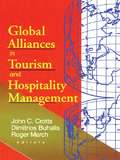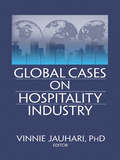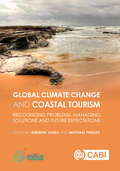- Table View
- List View
Gleams From Japan (Routledge Revivals)
by S. KatsumataFirst published in 1937 this is a collection of articles written by the author under the pseudonym 'Waseda Eisaku' for the Japan Tourist Bureau's magazine over twenty five years. Intended to satisfy the intellectual curiosity of cultivated tourists from abroad by giving the insider's view of all things Japanese, it was published as a book just before the outbreak of World War II. Writing in the first person, Katsumata becomes both guide and confidante, writing about his own travel experiences in Japan and about Japanese customs and practices that interest him, such as traditional incense ceremonies, or fishing with rod and creel. This personal approach results in an unusual selection of topics and itineraries including tray landscapes, old Japanese clocks, hot springs, Japanese humour, sumo wrestling, pines in Japanese scenery, the Japanese sun flag and Buddhist temple bells. The author not only describes, but draws the reader into his own experiences - his joy on buying an antiquarian book he cannot really afford, the monotony he feels when travelling too long through snowy landscapes, the delight he takes in telling you that the best bait for carp fishing is sweet potato. Katsumata's unconventional choice of subjects and his informal and individualistic writing style make this a refreshingly different guide to Japan, and a valuable record of the period in which it was written.
Gleanings in Buddha-Fields
by Lafcadio HearnLafcadio Hearn's books continue to charm and captivate readers, as the exotic subjects about which he wrote charmed and captivated him. Gleanings In Buddha-Fields presents more Hearn magic as he enters into the spirit of Buddhism asthough he were born into it. "I an individual," he writes, "an individualsoul! Nay, I am a population-a population unthinkable for multitude, even by groups of a thousand millions! Generations of generations, I am, aeons of aeons! Countless times the concourse now making me has been scattered, and mixed withother scatterings. Of what concern, then, the next disintegration?" (Shades of Walt Whitman!) Hearn says that if he were a god, dwelling in some old Izumo shrine on the summit of a hill, then "as air to the bird, as water to the fish, so would all substance be permeable to the essence of me. I should pass at will into the walls of my dwelling to swim in the long gold bath of a sunbeam, to thrill in the heart of a flower, to ride on the neck of a dragonfly." He writes of a trip to Kyoto, telling of hazy autumn rice fields, with dragonflies darting over the drooping grain; maples crimsoning above a tremendous gorge; ranges of peaks steeped in morning mist; and a peasant's cottage perched on the verge of some dizzy mountain road. Also, there are fine bits of realism, such as a cat seizing a mouse in the act of stealing the offerings placed in a Buddhist household shrine. In the chapter "Dust," Hearn tells of a children's playground, and says that children in all countries play at death. But the idea of ceasing to exist could not possibly enter a child's mind: the butterflies and birds, the flowers, the foliage, the sweet summer itself, only play at dying-they seem to go, but they all come back again after the snow is gone. "The real sorrow and fear of death arise in us only after the slow accumulation of experience with doubt and pain; and these little boys and girls being Japanese and Buddhists will never, in any event, feel about death just as you and I do . . . they have died millions of times already, and have forgotten the trouble of it, much as one forgets the pain of successive toothaches." In "Nirvana," Hearn writes that Buddhism, recognizing no permanency, no finite stabilities, no distinction of character or class or race, except as passing phenomena, is essentially the religion of tolerance. This thought-provoking reprint of an old favorite will delight people of all races and creeds.
Glen Canyon Dam
by Timothy L. ParksConstructed between 1956 and 1966 by the United States Bureau of Reclamation, Glen Canyon Dam on the Colorado River was a project of immense proportions. Even before the non-stop pouring of 5 million yards of concrete began, much work had to be accomplished. The town of Page, Arizona was established on a windswept mesa to house workers and their families, and the 1,028-foot Glen Canyon Bridge was built to carry men, materials, and equipment to the dam site. Though the dam has proven a controversial structure throughout its history, the massive undertaking of its construction was an undeniable triumph of ingenuity and determination.
Glen Cove Revisited (Images of America)
by Joan HarrisonSince its founding in the late 17th century as a mill town, Glen Cove has been simultaneously rural and industrial, patrician and working class. A city of multiple ethnicities and close family ties, Glen Cove has been home to generations of immigrants who came to work and stayed to live, as well as to the children of America's elite who built their summer homes on the shores of Hempstead Harbor. In Glen Cove Revisited, "The Heart of the Gold Coast" is seen as only insiders know it, through images of the mill ponds and barnyards, estates and factories, schools and neighborhoods, and the people, famous and unknown, which make up this microcosm of America.
Glen Ellyn (Images of America)
by Russ Ward Glen Ellyn Historical SocietyGlen Ellyn took its name from a Victorian real estate development whose massive promotional campaigns brought this unusually beautiful village to the attention of city dwellers eager to move their families away from the grimy, coal-fired environs of Chicago. Its story begins with hardy New Englanders who felled trees to build log cabins, broke the virgin prairie sod, and trapped wild game in the marshlands that would become greater Chicago, continuing through the radical changes that came with the railroad and the Civil War. From Potawatomi Indians and pioneers to an important Underground Railway station; from a luxurious lakeside health resort with a fabulous grand hotel to one of Chicago's premier suburban communities, Glen Ellyn presents the village's rich history with evocative photographs from the collection of the Glen Ellyn Historical Society.
Glen Rose, Texas (Images of America)
by Gene Fowler Somervell County Historical CommissionCharles Barnard, a Connecticut entrepreneur, settled in the Brazos Valley in 1849, running an Indian Trading Post. He built a gristmill in 1860 near the confluence of the Brazos and Paluxy Rivers, around which the town of Glen Rose sprang up. Captured here in over 200 vintage photographs and postcards is the history of this quintessential little Texas town, from its origins as a mill town, to the bedroom community of Fort Worth that it has become today. In its earliest days, settlers flocked to the region from the war-torn South during the Civil War. By the 1900s, both Somervell County and Glen Rose established fame as a tourist resort, offering springs and artesian waters to heal the body and spirit. Naturopathic and magnetic healers built sanitariums, while locals built tourist parks to entertain the crowds that came for rest and relaxation. Showcased here are images of the Hill postcard collection, which relay the intriguing story of Glen Rose as a recreation mecca, the Moonshine Capital of Texas during Prohibition, the discovery of the infamous dinosaur tracks, and its development as it enters the 21st century.
Glencoe, Illinois
by Glencoe Historical Society Ellen Kettler Paseltiner Ellen ShubartGlencoe, Illinois, "Queen of Suburbs," has long been heralded as an idyllic place to live. Situated on Lake Michigan in the heart of Chicago's North Shore, Glencoe was first settled in 1835 by Anson Taylor, a young storekeeper. Glencoe began to thrive thanks to one of its famous early residents, Walter Gurnee, president of the Chicago and Milwaukee Railroad. Gurnee moved to Glencoe in the mid-1850s and in 1855 established a railroad stop across the street from his home. His presence accounts for the town's accessibility and nucleus, but it was the vision of Dr. Alexander Hammond, who arrived in Glencoe in 1867, that helped to shape it into the model suburban town it has become. It is the people of the past and present who are at the heart of this community. This collection of over 200 images captures the heart and spirit of this all-American suburb, from the village's founding and early history as a farming community and utopian settlement to the annual Fourth of July parades that continue to trumpet through the town's center.
Glencoe Mill Village (Images of America)
by Don BoldenThe Glencoe Cotton Mill and its village have a story very similar to that of other 19th- and 20th-century mill communities across the South. The mill operated from 1880 until 1954, and its employees lived in mill houses and shopped at the company store. After it closed, the community faded into vacant houses, rutted streets, and weed-covered properties. Unlike other mills, however, Glencoe found a spark of new life. People interested in its history--headed by Graham resident Sarah Rhyne--joined together to see the property declared a national historic site. Work reclaimed the mill and preserved it for the future. Preservation North Carolina helped, as did a number of individuals from the area, and life returned. Many of the mill houses have been purchased and restored and are now home to a new generation of residents. The Textile Heritage Museum occupies the old office-store building and, with its displays, shows the history of Glencoe and southern textiles in general.
Glendale
by Ralph F. BradyGlendale, New York, lies just six miles from the center of the bustling metropolis of New York City but has always managed to retain its rural charm since its beginning. Taking its name from Glendale, Ohio, the town began with the unlikely occurrence of a piece of land changing hands in payment of a debt in the mid-1800s. Development of the land was slow in comparison to the surrounding communities, and many of the unoccupied parcels were bought up by people interested in building picnic parks and other types of recreational areas. Around that same time, a New York state law banned the construction of any more cemeteries in Manhattan, so Glendale's available land became equally attractive for this type of development. Glendale takes a journey back in time to the picnic parks, German biergartens, and early industries that took this community far from its origins as a farming town.
Glendale (Images of America)
by Carol J. St. Clair Charles S. St. ClairEstablished in 1892, nine miles northwest of Phoenix in the Salt River Valley of Arizona, Glendale at first attracted farmers with strong Protestant religious convictions. Soon, however, others began to settle in the town and on the rich farmlands of the area. Although predominantly Anglos, the settlers that came in the latter 1890s and early decades of the 1900s included various ethnic minorities. Each group had a significant role in the city's development into an important agricultural center that shipped produce all over the country. World War II and its influx of servicemen to train at Glendale's Luke and Thunderbird airfields brought permanent changes to Glendale. The population doubled and doubled again and again. Today the city-Arizona's fourth largest-is a metropolitan area of 59 square miles and close to 250,000 people. This volume offers windows to understanding the growth and development of Glendale over the years.
Glendive (Images of America)
by Dr R. Booker JrGlendive was founded in the early 1880s, and its growth was promoted and sustained by the Northern Pacific Railroad. Legend holds that Sir George Gore, on a hunting expedition with famed mountain man Jim Bridger, named a creek in the area Glendale Creek after a similar one in his native County Donegal, Ireland. Over the years, the word "Glendale" somehow transformed into "Glendive." Prior to the arrival of European Americans, indigenous peoples, including the Crow and the Lakota Sioux, called the area home. The arrival of the Northern Pacific in 1881, along with the passage of the Enlarged Homestead Act in 1909, lured people from America and abroad to this isolated region to pursue their version of the American dream.
Glenn County
by Anna CanonA brief look into the history of Glenn County will show you that Glenn County was created out of the northern portion of Colusa County on March 11, 1891, and was named after the prominent wheat farmer known as the "Wheat King of the World," Dr. Hugh J. Glenn. A more in-depth look at the formation of Glenn County will show that its separation from Colusa County created a fierce contest among the people of those counties. Trains filled with hundreds of citizens traveled to Sacramento to lobby the governor; a few people were even hired from outside of the county to vote for the separation. There are reports that guns were brought to the courthouse for the first election of Glenn County officials in May 1891. To this day, there remains an air of discontent between the two counties.
Glennville (Images of America)
by Glennville-Tattnall MuseumThe area that would become modern Glennville was first opened to settlement in 1773. In the early decades of the 19th century, settlers converged around the intersection of Hencart Road and Reidsville-Johnston's Station Road. The community that grew around this intersection came to be known as Philadelphia--a name it would hold until 1889, when the village's first post office was established. The village was then renamed after a prominent schoolteacher and minister, Glenn Thompson, who was instrumental in securing the post office for the village. Glennville was incorporated as a town in 1894 and continued to grow remarkably through the coming decades until it became the commercial and agricultural hub of Tattnall County.
Glens Falls: People And Places (Images of America)
by Gwen Palmer Stan Malecki Bob BayleGlens Falls presents a photographic essay of a community on the Hudson River, midway between Saratoga Springs and Lake George. The book spans the years from 1860 to 1925, when Glens Falls was reaching its peak in economic, social, political, and cultural growth. Depicted in stunning images are the city's simple beginnings, the days of dirt roads traveled by horse and buggy, and its cultural emergence with opera houses, exquisite mansions, and public transportation. Clearly portrayed are the educational, religious, business, and recreational opportunities of the time.
Glens Falls People and Places
by Gwen Palmer Stan Malecki Bob Bayle Lillian CasolaThe name Glens Falls went through a series of changes, beginning simply as "the Corners," after a bend in the road from a major military installation in Fort Edward. In the 1700s, it was known as Wing's Falls, and later Pearlville, Pearl Village, and Glenn's Falls; but by the middle of the 1800s, it was determined to be Glens Falls, one of the wealthiest villages in the state. It was the people who settled in the town that helped to shape it. The lumber barons provided the financial backing to begin banking and insurance institutions and served as officers of every major business and governmental agency in town. Glens Falls People and Places covers the lives of the prosperous and preposterous people and their contributions to the city's development through the 20th century.
Glenshaw (Images of America)
by Violet F. RoweCaptivating and entertaining, this new collection of historic images brings to life the past of Glenshaw, Pennsylvania, focusing on the period between the mid-1800s to the 1940s. With insightful captions and breathtaking images, readers are introduced to many of the early residents who shaped the future of this area of Shaler Township, and we are transported back in time to see early homes and places of work, play, worship, and education. In 1800, John Shaw Sr. purchased 600 acres of land just 8 miles north of the city of Pittsburgh. He built a log sawmill to prepare lumber for his home, and later built a log gristmill which stood until 1845 when his son replacedit with a larger mill. The new mill stood on property across from the local school, and the area became known as "Shaw's Glen. During the period covered in this book, Shaler Township, incorporated in 1837, grew from a quiet milltown of just 2,000 residents to a bustling suburb of the Steel City. Today, over 33,000 people call this area home.
Glenview
by Beverly Roberts DawsonFollowing the signing of the treaty of 1833, which required that local Potawatomi tribes relocate west of the Mississippi River, European settlers began to arrive in the area now called Glenview. Primarily of English and German origin, they established farms and trading posts. The Great Chicago Fire of 1871 had a profound effect on the hamlet. Lumber from the forests of Wisconsin used to rebuild the city was moved from the north via rail. By 1872, the Chicago, Milwaukee, St. Paul and Pacific Railroad laid the first set of tracks from Wisconsin to Chicago; the line brought prosperity to local residents. In 1899, the village was incorporated. The first mayor, Hugh Burnham, a nephew of Chicago architect Daniel Burnham, is credited with its name--Glen View. The community evolved into a mosaic of truck farms, major industry, small businesses, country clubs, polo fields, entrepreneurs, and colorful characters. Glenview maintained its ambiance as a "village of homes and gardens" until the latter years of the 20th century.
Glenville
by Schenectady County Historical SocietyGlenville recounts the rich and varied history of the town on the north side of the Mohawk River that crowns Schenectady County. Long before it became an incorporated town, Glenville was the site of the last great struggles between the Mohawk and Mohican Indians for control of the Mohawk Valley, the region's first European settlement (1661), and numerous raids and encampments during the colonial wars of the 18th century. From farming to factories and railroads to roadhouses, Glenville is a compelling look at the architecture, culture, industry, and economic forces integral to the lives of residents past, present, and future.
A Glimpse at the Art of Japan
by James Jackson JarvesFirst published in 1876, when many considered Japanese art a mere curiosity, A Glimpse at the Art of Japan presents Jarves remarkable examination of the problems of Japanese aesthetics, offering a penetrating analysis of the historical, religious, and social influences on the development of art in Japan. Supporting the thesis that art gives true expression to the aspirations of a nation, Jarves discusses such issues as: the influence of Shintoism and Buddhism on Japanese art; Buddhism as the "nursery of art"; the Japanese aesthetic ideal and the Grecian form; the literature and poetry of Japan; Japanese decorative and ornamental art; and the Japanese conception of Nature-all in addition to a continuing discussion of the distinguishing characteristics of Japanese aesthetics.
A Glimpse of Eden
by Evelyn AmesA safari in East Africa brings a couple to see Africa with new eyes and gives them a greater appreciation of its wildlife and man's natural heritage.
Global Airlines: Competition In A Transnational Industry
by Pat HanlonGlobal Airlines: Competition in a Transnational Industry presents an overview of the changing scene in air transport covering current issues such as security, no frills airlines, ‘open skies’ agreements, the outcome of the recent downturn in economic activity and the emergence of transnational airlines, and takes a forward looking view of these challenges for the industry.Since the publication of the second edition in 1999 major changes have occurred in the industry. The ‘rules of the game’ in air transport are now beginning to change; and it is time to take the story forward. This third edition contains nine new chapters and tackles the following issues amongst others:* Security: The tragic events of 11 September 2001, followed by the war in Iraq, and the resultant heightened tensions over security and passenger safety. * Financial instability: the cyclical downturn in economic activity has led some airlines to the verge of bankruptcy. Even some large well-established carriers are not immune from this. How can the industry look to survive?* Attaining global reach: implications of transborder mergers, open skies agreements and the transatlantic Common Aviation area. Can full globalisation ever be reached? * Low-cost carriers and e-commerce: as both increase, how much the industry re-structure and deal with issues associated with increased passenger traffic and decreased labour requirements?* Airport capacity: Air traffic is estimated to grow at a long-term average annual rate of 5 per cent per annum. But many airports in many parts of the world are already reaching their capacity limits. How can this be overcome and are the environmental implications?Using up to date data and case studies from major international airlines such as United Airlines, British Airways, and Qantas amongst many others, Global Airlines provides a comprehensive insight into today’s global airline industry.
Global Alliances in Tourism and Hospitality Management
by Dimitrios Buhalis John CrottsTarget your business strategies to fit specific tourist cultures!Since Thomas Cook packaged the first tour in 1841, hospitality and tourism enterprises have forged long-term alliances with one another. Yet research suggests that most such alliances will fail. What goes wrong? How can tourism professionals take advantage of all the ben
Global Cases on Hospitality Industry
by Timothy L. LockyerGet a comprehensive research-based look at real life hospitality industry issues from leaders in the field Global Cases on Hospitality Industry is a comprehensive examination into hospitality issues around the world. This detailed look at the industry’s dynamics uses an international perspective that provides reader understanding by spanning several strategic and functional areas in management practices. Leading academics, trainers, and consultants from around the globe offer research-based perspectives on real life issues in this competitive industry. This important text extensively explores various aspects of the industry from both Asian and Western countries, providing important insights into policymaking, research, consulting, and teaching. Global Cases on Hospitality Industry presents extensively-researched illustrative case studies and accounts of revealing management practices from experts around the world. This book explains both the positive and negative impact of certain real life policy and management decisions in various aspects of the industry. This text discusses topics such as marketing, human resources, strategy, entrepreneurship, the use of technology, and ethics, using inside looks into different hospitality and travel and tourism companies. The book includes numerous figures and tables to clearly illustrate research data. Topics in Global Cases on Hospitality Industry include: consumer marketing research price promotions consumer behaviors bed and breakfast expectation analysis assessment of service quality company organizational structure labor productivity human resource issues franchise restaurants impact around the world tour operator strategies similarity of problems between the hospitality and tourism industries heritage tourism societal effects of tourism development ethical challenges and much more!Global Cases on Hospitality Industry is essential reading for hospitality management educators, students, trainers, and researchers in services management.
Global Climate Change and Coastal Tourism: Recognizing Problems, Managing Solutions and Future Expectations
by Abdullah Akbas Nazan An Angela Anthonisz Paulo Borges Stephen William Boyd Huong T. Bùi Jeremy Buultjens Helena Calado Rita Cannas Salvador Anton Clavé James Andrew Cooper Janice Cumberbatch Osman Cenk Demiroglu Denyse S. Dookie Danielle EdwardsClimate Change and Coastal Tourism includes case studies on climate change and coastal tourism that explore current threats to, and consequences of, climate change on existing tourism coastal destinations. It assesses management and policy options for the future sustainability of threatened tourism coastal destinations. The cases discussed are from all regions of the world - Europe - The Americas - Asia - Africa -Australasia and synthesise findings to make recommendations that can be used to promote strategies that ameliorate projected impacts of climate change on coastal tourism infrastructure - and in turn promote the future sustainability of coastal tourism destinations.
Global Climate Change and Coastal Tourism
by Andrew Jones Michael PhillipsClimate Change and Coastal Tourism includes case studies on climate change and coastal tourism that explore current threats to and consequences of climate change on existing tourism coastal destinations. It assesses management and policy options for the future sustainability of threatened tourism coastal destinations. The cases discussed are from all regions of the world: Europe, The Americas, Asia, Africa, and Australasia. The book synthesize findings to make recommendations that can be used to promote strategies that ameliorate projected impacts of climate change on coastal tourism infrastructure and in turn promote the future sustainability of coastal tourism destinations.

